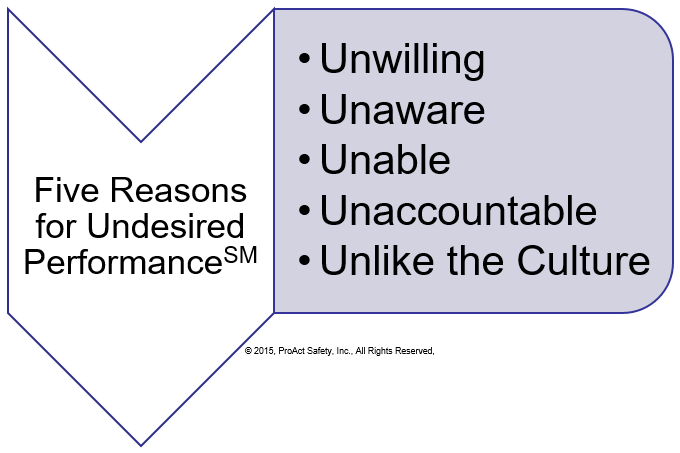IDC Industrial Review - May 2016
By: Shawn M. Galloway
Printable Version
Occupational Health & Safety - November 2015
Printable Version
Leaders set expectations and manage the influences on them, but some spend too much time managing displeasing results. No effective leader can truly expect perfect performance from every one of their direct reports, one-hundred percent of the time. Those who have unrealistic expectations misunderstand human behavior and its influences, and likely create undesirable work environments. Managing, coaching or counseling undesired performance is an integral part of any leader's responsibilities. How is this handled in your organization?
Human resources is too often used as a disciplinary crutch. Training departments are engaged to communicate information to change behavior which is expected to somehow magically result in the desired outcomes. Accountability is used more as a response to poor results: "We didn't get the results we wanted. Who needs to be held accountable for this?!" Rather, accountability should be used as a positively-viewed tool to proactively shape both behavioral and results expectations. Culture, an increasing frequent topic among board room discussions, is looked upon as the next step-change opportunity.
All these departments, tools and topics have merit when performance improvement considerations are explored, but which one is the best tool for the job? People do things for a reason. If you do not understand the reason, your efforts to change behaviors and results will be unsuccessful, or limited, at best.
A five-part model was developed for client organizations to increase the effectiveness of how they manage influences on desired and undesired performance. These are explored below.

Unwilling - All organizations will eventually change, evolve, restructure, refocus, downsize, rightsize, brightsize, merge or align. Not everyone will want to remain onboard or support the new direction. All employment is a behavioral rental agreement. If someone is not willing to do what is expected of them, sometimes deselection is the necessary approach.
Unaware - When expectations are shared, it is typically the necessary results that are communicated, leaving it to the individual to ascertain how best to achieve them. If people are unaware of what they need to do or how they need to do it, we must ensure communication is clear and both performance and results based. Communication is more about verifying knowledge transfer than confirming you were heard. Certainly autonomy is desired and micromanaging is not. Sometimes, however, the way things are accomplished is most important. Further, for successful organizations, clear responsibilities are necessary to fulfill certain roles. Responsibilities are best behaviorally-defined. How well are these understood?
Unable - If someone lacks either the skills or confidence, or something limits or creates barriers to their performance, we must enable them. Sometimes enabling comes in the form of training, or sometimes coaching is used to build competence and confidence. These will be limited, however, in yielding value if something is standing in the way. Imagine an inaccessible tool.
Unaccountable - True accountability is making sure people are doing what is necessary to accomplish the results, prior to verifying results? Effective accountability has two sides: proactive and reactive. Proactive accountability looks at ensuring the behaviors are desirable; reactive accountability looks at the results. Both require a balance of consequences to shape performance. What happens when people do what is necessary; what happens when they do not? What happens when we get the desired results; what happens when we don't?
Unlike the Culture - When a newly onboarded employee or contractor is later exposed to the masses that say, "Let me show you how we really do it around here," it is a powerful force sure to shape decisions and behavioral choices. Culture is what is common among a group of people, both between their heads (i.e., beliefs) and across their behaviors. If the expected behaviors of the individual's leader is not like what is commonly observed by peers and other levels within the organization, the leaders is soon to be disappointed.
Prior to reacting to misalignments with expectations, invest time in understanding the reason. We must think strategically about how we will achieve the desired results and, when necessary, deal with undesired performance. Strategy is a framework of choices, tradeoffs or bets the organization makes to determine how to capture and deliver sustainable value over time. Strategy, therefore, is: How do we win? Sustainable value in this situation is dependable and repeatable performance and results. This only comes from an approach proactively focused on understanding and overcoming these powerful influences on employee performance before they become a problem.

Shawn Galloway, CEO of ProAct Safety, is an expert in safety excellence. With almost thirty years of experience, he is a highly sought-after advisor, keynote speaker, and expert witness. Shawn has become a trusted partner to leading organizations across various industries worldwide. He ranks in the top 1% of the most prolific writers in his field, having authored over 500 articles and several bestselling books. He also launched the world's first safety podcast, Safety Culture Excellence©. As a recognized authority in safety, Shawn has received awards such as being named among the Top 50 People Who Most Influence EHS and a Top 10 Speaker, among others.
He is a regular guest on Bloomberg, Fox News, The Daily Mail, Dubai One, U.S. News & World Report, Sirius Business Radio, Wharton Business Daily, and leading safety magazines and podcasts. Shawn also serves as a member of the Harvard Business Review Advisory Council, Forbes Business Council, and Fast Company Executive Board, enabling his influence to shape safety thinking and strategy at the executive level.
